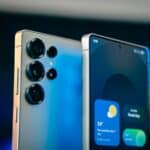The Stelo Glucose Biosensor System marks a significant advancement in personal health monitoring. Created by Dexcom, this innovative device has become the first over-the-counter continuous glucose monitor approved by the FDA. The Stelo wearable biosensor tracks glucose levels 24/7, revealing how food, exercise, and sleep affect your health without requiring a prescription. This breakthrough makes glucose monitoring accessible to adults 18 and older who want to understand their body’s glucose patterns.
Unlike traditional glucose monitors designed for diabetes management, the Stelo system serves a broader audience interested in metabolic health. The device won a 2024 Verge Award for its contribution to health technology. It’s important to note that Stelo differs from medical CGMs like the Dexcom G7 as it doesn’t include alerts for high or low glucose levels, making it unsuitable for insulin users or those who need to manage hypoglycemia.
Consumers can purchase the Stelo system directly, and it’s eligible for FSA/HSA spending. The system helps detect normal glucose levels as well as low or high readings, giving users insights into their metabolic health that were previously only available through medical devices.
Stelo Glucose Biosensor System: Latest Info & Troubleshooting Guide
The Stelo Glucose Biosensor is Dexcom’s latest innovation in continuous glucose monitoring (CGM), designed for people without diabetes who want to track their glucose trends for wellness, fitness, or metabolic insights.
Unlike Dexcom G7, which is a medical-grade CGM for diabetes management, Stelo focuses on personal glucose awareness — helping users understand how food, exercise, and lifestyle choices impact glucose levels.
🔍 Overview: What Is the Stelo Glucose Biosensor?
- Manufacturer: Dexcom, Inc.
- Launch: 2024 (U.S.)
- Purpose: Non-prescription glucose biosensor for wellness tracking.
- App: Stelo by Dexcom (available on iOS and Android).
- Wear Duration: Up to 15 days per sensor.
- Target Users: Health-conscious individuals, athletes, and those interested in metabolic health optimization.
📱 How the Stelo System Works
- Apply the Stelo sensor — a small, disposable biosensor placed on the back of the upper arm.
- Connect via Bluetooth to the Stelo app on your smartphone.
- The sensor continuously measures interstitial glucose levels and displays real-time data.
- The app provides glucose trend graphs, event tagging (meals, workouts, etc.), and insight summaries.
💡 Stelo uses the same core Dexcom sensor technology as the G7, but it’s calibrated and regulated for wellness tracking, not for diabetes treatment decisions.
🆕 Latest Updates (as of November 2025)
According to Dexcom’s official resources and recent user documentation:
- Expanded device compatibility: Now supports most iPhones (iPhone 12 and later) and Android 12+.
- Improved Bluetooth stability: Firmware updates in the Stelo app (v1.3 and later) reduce signal dropouts.
- New “Trends” dashboard: Provides detailed glucose response analysis for meals and activities.
- Enhanced onboarding: Updated in-app tutorials and SteloBot support for setup and troubleshooting.
⚠️ Common Stelo Issues and How to Fix Them
Below are the most frequent problems users encounter, with solutions from Dexcom’s official troubleshooting page and Levels’ Stelo support guide.
🧩 1. Signal Loss or “No Data” Message
Cause: Bluetooth disconnection or temporary interference.
Fix:
- Keep your phone within 20 feet (6 meters) of the sensor.
- Ensure Bluetooth and location services are enabled.
- Avoid wearing the sensor under tight clothing or metal accessories.
- Restart your phone and reopen the Stelo app.
- If the issue persists, remove and re-pair the biosensor in the app.
⚙️ 2. “Brief Sensor Issue” Alert
Meaning: The sensor temporarily can’t read glucose values (often due to pressure, temperature, or signal fluctuation).
Fix:
- Wait 10–15 minutes — readings usually resume automatically.
- Avoid pressing or sleeping directly on the sensor.
- If the issue continues beyond 30 minutes, contact Stelo Support for guidance.
(Reference: Stelo FAQ – What does Brief Sensor Issue mean?)
🔋 3. Early Sensor Session Ended
Cause: Sensor dislodged, adhesive failure, or internal sensor error.
Fix:
- Do not attempt to restart the same sensor.
- Contact Stelo Support or use the in-app SteloBot to report an early session.
- You may qualify for a replacement sensor.
(Reference: Levels Support – Common Stelo Issues)
📶 4. Pairing or Connectivity Problems
Fix:
- Make sure your phone’s OS and the Stelo app are up to date.
- Turn Bluetooth off and on again.
- Forget other Dexcom or Stelo devices in Bluetooth settings.
- Reinstall the Stelo app if pairing fails repeatedly.
- Restart your phone before retrying.
💧 5. Adhesive or Skin Irritation
Fix:
- Clean the application site with alcohol and let it dry completely before applying.
- Avoid lotions or sunscreen near the area.
- If irritation occurs, remove the sensor and contact support for advice.
🧠 Pro Tips for Best Performance
- Keep your phone’s battery optimization settings relaxed for the Stelo app (especially on Android).
- Avoid swimming or showering for at least 1 hour after sensor application.
- Tag meals and workouts in the app for more accurate trend analysis.
- Replace the sensor every 15 days for consistent accuracy.
🛠️ When to Contact Stelo Support
Reach out if:
- The sensor fails before 15 days.
- You repeatedly lose signal despite troubleshooting.
- You experience persistent skin irritation or inaccurate readings.
Contact Options:
- Visit the official Stelo Support Center.
- Use the SteloBot in the app to report issues or request replacements.
- Check the Troubleshooting FAQ for quick answers.
✅ Summary
| Issue | Likely Cause | Fix |
|---|---|---|
| No signal or data | Bluetooth disconnect | Re-pair device, keep phone nearby |
| Brief Sensor Issue | Temporary read error | Wait 10–15 min, avoid pressure |
| Session ended early | Sensor fault or adhesive issue | Contact support for replacement |
| Pairing failure | App or OS glitch | Restart, reinstall, update software |
| Skin irritation | Adhesive sensitivity | Clean skin, remove if persistent |
Official Resources:
- Stelo Guides & Resources – Dexcom
- Stelo Troubleshooting FAQs
- Stelo Support Center
- Levels Support – Common Stelo Issues
Key Takeaways
- Stelo is the first FDA-cleared over-the-counter continuous glucose monitor that tracks levels 24/7 without requiring a prescription.
- The wearable biosensor reveals how daily activities like eating, exercising, and sleeping affect your glucose patterns and overall health.
- While perfect for health-conscious consumers, Stelo lacks alerts for glucose extremes and isn’t suitable for insulin users or managing hypoglycemia.
Stelo Glucose Biosensor System Overview
The Stelo Glucose Biosensor System represents a significant advancement in glucose monitoring technology. It offers an accessible way for users to track their glucose levels without a prescription, while providing detailed insights through a dedicated mobile application.
Innovation and Development
Stelo, developed by Dexcom, stands out as the first Over-the-Counter glucose biosensor available in the market. This breakthrough innovation eliminates the need for a healthcare provider’s prescription, making glucose monitoring more accessible to the general public.
The system emerged from Dexcom’s extensive experience in continuous glucose monitoring technology. Unlike traditional prescription-only monitors, Stelo targets a broader audience interested in understanding their glucose patterns.
The development process involved rigorous testing to ensure accuracy and reliability. The FDA’s clearance of this device marked a significant milestone in healthcare innovation, opening new possibilities for preventive health management.
Dexcom’s transition into the OTC market with Stelo demonstrates the growing trend of putting healthcare tools directly into consumers’ hands.
Key Features and Capabilities
The Stelo Glucose Biosensor System helps detect normal (euglycemic) and abnormal (dysglycemic) glucose levels through a wearable sensor. This small device attaches to the body and continuously monitors glucose values.
The system offers detailed insights through its dedicated app, including:
- Target range notifications
- Glucose spike alerts
- Trajectory tracking
- Educational content about glucose management
Users can easily view their glucose trends and patterns in real-time. The app provides actionable information about how different factors might affect their levels.
The biosensor works continuously, eliminating the need for fingerstick testing throughout the day. This non-invasive approach makes regular monitoring more comfortable and convenient.
The user-friendly interface makes the technology accessible even to those without medical backgrounds, expanding the potential user base beyond traditional diabetes management.
Impact on Personal Health Management
The Stelo Glucose Biosensor System is transforming how people manage their health by providing real-time glucose data that supports informed decision-making. This technology empowers users to take control of their metabolic health through continuous monitoring and personalized insights.
Improving Metabolic Health
The Stelo system helps users understand how their bodies respond to different foods, activities, and daily routines. Studies show that continuous glucose monitoring leads to improved awareness of metabolic patterns.
Users can identify which foods cause glucose spikes and which help maintain stable levels. This knowledge is crucial for those with prediabetes or at risk for Type 2 diabetes.
According to search results, 32% of participants using glucose sensors reported increased physical activity. This suggests that seeing real-time data motivates people to make healthier choices.
Sleep quality and glucose levels are closely linked. The Stelo system can help users understand this connection and make adjustments to improve both sleep and metabolic health.
Support for Lifestyle Decisions
The Stelo Glucose Biosensor provides actionable insights that guide users toward better lifestyle choices. Rather than guessing about diet impacts, users can see exactly how specific foods affect their glucose levels.
Exercise decisions become more informed when users can observe how different activities impact their metrics. This feedback loop encourages consistent physical activity.
The system helps users understand the relationship between stress and glucose levels. This awareness can lead to better stress management techniques.
Search results indicate the Stelo system helps users “better understand how lifestyle and behavior modification, including diet and exercise, impact glucose” levels. This real-time feedback creates a powerful learning tool.
The smartphone integration makes health data easily accessible, allowing users to track patterns over time and make adjustments accordingly.
Glucose Monitoring and Disease Management
For those with prediabetes or Type 2 diabetes, the Stelo system offers a non-invasive way to track glucose without frequent finger pricks. This continuous data helps prevent problematic hypoglycemia episodes.
The system is FDA-cleared as an over-the-counter device for adults 18 and older, making glucose monitoring accessible without a prescription. This represents a significant advancement in diabetes care.
Search findings show that 27% of participants reported improved medication adherence when using a glucose sensor. Seeing immediate effects of medication helps reinforce proper usage.
The technology “fostered a deep” understanding of personal health patterns, according to one search result. This deeper awareness helps users make connections between behaviors and health outcomes.
Long-term data collection enables users and healthcare providers to make more informed treatment decisions based on comprehensive glucose patterns rather than isolated readings.
Frequently Asked Questions
The Stelo glucose biosensor system offers several features and capabilities that users often have questions about. These common questions address compatibility, functionality, privacy considerations, and technical specifications.
What are the key improvements in the latest version of the Stelo glucose biosensor?
The latest Stelo glucose biosensor offers improved accuracy and reliability in glucose tracking. It received FDA clearance for over-the-counter use in March 2024, making it the first continuous glucose monitoring system available without a prescription.
The system features enhanced sensor technology that provides more consistent readings throughout the sensor’s lifespan. Users can now experience longer wear times with reduced signal loss issues, which was a common concern in earlier versions.
The new biosensor also comes with improved adhesive for better skin compatibility and longer wear time. This advancement helps maintain consistent contact between the sensor and the skin for more reliable measurements.
Is the Stelo glucose biosensor compatible with all types of smartphones?
The Stelo mobile app works with many smartphones, but not all devices are compatible. The system requires specific operating system versions to function properly.
Most recent iOS and Android devices support the Stelo app, but users should check the compatibility list on the official Stelo website before purchasing. This ensures their smartphone can properly pair with and display data from the biosensor.
Connectivity features have been enhanced to maintain more stable connections between the biosensor and smartphones. This improvement addresses previous pairing and connectivity issues reported by users.
How does the Stelo biosensor ensure user data privacy and security?
Stelo implements industry-standard encryption protocols to protect glucose data during transmission and storage. All communications between the biosensor and smartphone app are secured to prevent unauthorized access.
The system complies with health data privacy regulations to ensure user information remains confidential. Personal health data is stored securely, with users maintaining control over who can access their information.
Dexcom, the maker of Stelo, has established robust data protection policies. These policies define how user data is handled, stored, and the circumstances under which it might be shared with healthcare providers.
What are the steps for calibrating the Stelo glucose biosensor for precise readings?
The Stelo glucose biosensor is designed to work with minimal calibration requirements. After insertion, users should follow the initialization process in the Stelo mobile app, which guides them through any necessary setup steps.
The system includes automated sensor warm-up periods to ensure accuracy. This typically takes a short time after application before the sensor begins providing reliable glucose readings.
Users experiencing accuracy concerns can follow troubleshooting steps in the app or support materials. The Stelo support section offers guidance for addressing potential calibration issues and improving reading accuracy.
What is the expected battery life of the Stelo glucose biosensor in the latest model?
The Stelo glucose biosensor comes with a built-in battery designed to last for the entire sensor wear period. Each sensor is pre-charged and activated upon application to the body.
Users do not need to worry about charging the biosensor during its operational lifespan. The power management system optimizes energy use to ensure consistent performance throughout the entire wear period.
The mobile app will display notifications when a sensor is nearing the end of its operational life. This gives users adequate time to prepare a replacement sensor to maintain continuous monitoring.
Are there any advanced features introduced in the newest iteration of the Stelo biosensor?
The latest Stelo system introduces improved trend analysis capabilities. These enhancements help users identify patterns in their glucose levels over time for better health management.
The updated mobile app now offers customizable alerts and notifications. Users can set personalized thresholds for high and low glucose readings based on their specific needs.
Data sharing capabilities have been expanded to allow users to share their glucose information with family members or healthcare providers. This feature supports better collaborative care and monitoring for those who need assistance managing their glucose levels.






